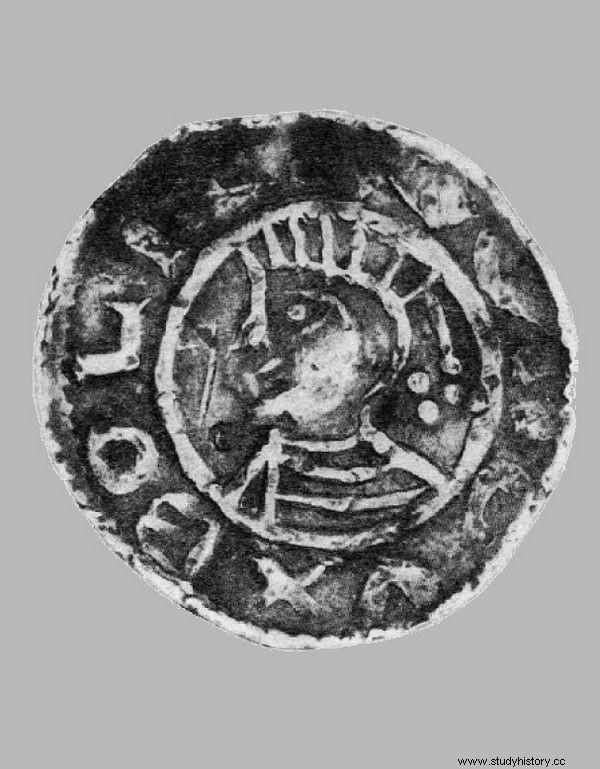The feathers on his head were worn by the King of England, on the advice of the Pope himself. They were paraded by the empress of Byzantium and even Justinian the Great himself. One of the most famous Polish monarchs also had his own headdress. And it was by no means a worthless prop!
The starting point is one of the coins of Bolesław the Brave, the denarius called - from the inscription on it - by numismatists DVX INCLITVS. The Polish ruler has a headdress on it. This was based on the coin of Ethelred II of the Helpless, then king of England, depicting him with a tiara with feathers on his head.
In the country of the first Piasts, coins were important primarily as an element of propaganda, not as a means of payment. If Bolesław the Brave told his minters to immortalize themselves in a feathered crown resembling an Indian plume it had to have a specific purpose. It was by no means "But this Ethelred from England has a nice coin, let's do the same."
Chrobry wanted to demonstrate his power over Moravia. He probably mastered this beautiful land in 1002. By carefully interpreting the archaeological finds and using arguments from analogies, one can guess that first he set fire to the towns that resisted him, and then he got along with the local elites, who recognized him as their ruler. In later years, "Bolesław's Moravian warriors" often supported him in battles with the German king Henry II and his allies.

After the conquest of Moravia, many warriors from those lands fought in Chrobry's team. The illustration shows a painting by Michał Bylina entitled "Team of Bolesławów"
Moravia remained within the borders of the Piast state until 1031 (sometimes other dates are proposed, such as 1021), when it was conquered by Brzetysław, the son of the Czech prince Ołdrzych. As the ruler of Moravia, he began minting coins with the inscription BRACIZLAV, on which was depicted ... a diadem with feathers.
Denari will tell you the truth?
Many years ago, the Czech numismatist Pavel Radoměrský stated that the feathered crown was a symbol of power over Moravia. It's quite a challenge trying to guess what is depicted on a denar from almost a thousand years ago, at least something with feathers is up. Several years ago, the Polish historian Paweł Stróżyk pointed out that:
The obverse of the denarius with the inscription BRACIZLAV, issued by Brzetyslav I as the Moravian ruler, indeed seems to represent (...) a ceremonial headdress in the shape of a diadem-loin with visible pinnacles.
There is also no doubt that the denarii of Bolesław the Brave with the inscription DVX INCLITVS were to be a clear message that he is the ruler of Moravia, although it definitely did not determine whether we are dealing with a feathered crown. - Whether this ceremonial headgear is a diadem with feathers - as indicated by a detailed, for a coin, drawing made of a Moravian denarius - or not, we will certainly not decide - he wrote in an article published in 2002 in the prestigious Annals of History.
The era of feathered crowns
There are no other sources, but it cannot be doubted that there must have been a symbol of exercising power over Moravia, something like the Sword in Stone in Arthurian legends or the sacred Andal armband from the 9th-century novel Ja, Dago Zbigniew Nienacki. Meanwhile, a feathery crown would fit perfectly, because in the early and mature Middle Ages, monarchs often decorated their headgear in this way.
It seems to be a Byzantine influence, because both Emperor Justinian I (died in 565) and several empresses of Constantinople wore tiaras decorated with peacock feathers. With time, customs were also picked up in Western Europe. For example, in 1186 Pope Urban III sent the English king Henry II Plantagenet a crown made of gold-framed peacock feathers. It was intended for the addressee's son, Jan, as a sign of confirmation of his authority over Ireland. By the way:this Jan is the evil prince John without Earth from the Robin Hood novels and movies.

The image of Brave in a feathered crown, stamped on the denar.
The remnants of feathered crowns can be found in hats decorated with feathers in later eras. Ethnographers add their pennies, because "a crown of feathers, used either on its own or adorning a garment in the form of a forehead," was still worn in some parts of Latvia, Polesie, eastern Subcarpathia, Serbia, western Finland and Thuringia in the interwar period. As Kazimierz Moszyński wrote in 1929 in the monumental Kultura ludowej Slavian “And this outfit is compared by the authors with the Native American ones; of course it is only about purely external general similarity. ”
So Bolesław Chrobry parading in something reminiscent of an Indian plume turns out to be not only fun in the graphic program, but something quite firmly embedded in historical reality.
